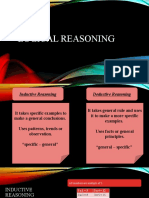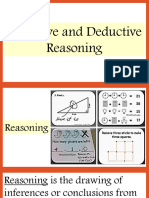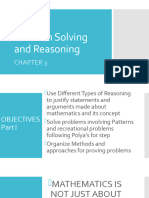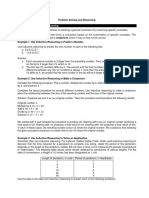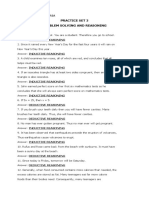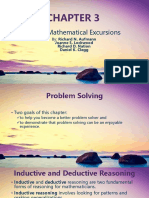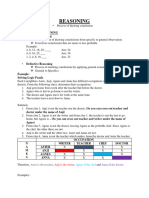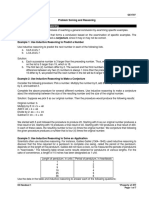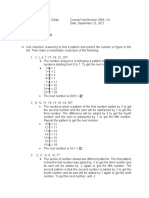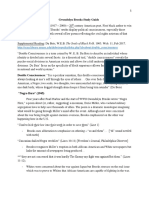Activity 1
General Instruction: You are not allowed to send a copy of this activity to
students who are not part of your class. If ever the activity is sent to another
section, the whole class will be deducted 20 points each. Read the
instructions carefully before answering. Submit your work after the
scheduled time at the BSBA Faculty Office.
Note:
Inductive Reasoning – Uses patterns, observations, or examples
to form a general conclusion.
Deductive Reasoning – Uses facts, definitions, rules or properties
to reach a specific conclusion.
Directions: Read each statement carefully. Decide whether the reasoning
used is Inductive or Deductive. Copy and answer in a whole sheet of yellow
paper. Write I if it is (Inductive) and D id (Deductive). Be ready to explain
your answer next meeting.
1. Every time Anna eats chocolate, she feels happy. She concludes that
eating chocolate will always make her happy.
2. All mammals have lungs. A whale is a mammal. Therefore, a whale has
lungs.
3. The sun has risen in the east every morning so far. It will rise in the
east tomorrow.
4. If a number ends in 0, it is divisible by 10. The number 430 ends in 0.
Therefore, it is divisible by 10.
5. Miguel notices that every Friday his teacher gives a short quiz. Today is
Friday, so he thinks there will be a quiz today.
6. All squares are rectangles. Since ABCD is a square, then ABCD is also a
rectangle.
7. Jessa met three people from City X, and they were all friendly. She
concludes that all people from City X are friendly.
8. If a polygon has exactly three sides, then it is a triangle. Shape XYZ
has three sides, so it is a triangle.
9. The last five times it rained, Paul forgot his umbrella. He concludes that
he will probably forget his umbrella the next time it rains.
10. Every apple I have seen so far is red. I conclude that all apples
are red.
� Activity 2 (Dyad Activity)
Directions: Find a partner within the class, discuss, and solve the following
problems together. On a whole sheet of yellow paper, copy and answer the
questions. Each student must have their own answer sheet.
Note: Polya’s Four-Step Problem Solving Strategy
Step 1: Understand the Problem
Ask yourself. What is asked in the problem? What are the
information given? What do I need to look for?
Strategy: Restate the problem in your own words. Read the twice
or more to understand the problem.
Step 2: Devise a Plan
Think of different strategies: Look for a pattern, make a table,
guess and check, work backwards, or use equations.
Choose the strategy that fits best.
Step 3: Carry Out the Plan
Solve step by step carefully.
Be patient – if one strategy fails, try another. Remember that there are
26 letters in the English Alphabet. If plan A won’t work, there is still
Plan B, C, D up to Z.
Step 4: Check your solution. Does it make sense? Did you answer the
question?
Problems:
1. The product of the ages of three teenagers is 4590. None of them are
the same age. Find their ages.
2. A farmer has chickens and pigs. Altogether, there are 50 heads and
132 legs. How many chickens and pigs does the farmer have?
3. Chairs are arranged in rows. The first row has 10 chairs, the second has
12, the third has 14, and so on. How many chairs are in the 15th row?
4. Pick a number, multiply it by 8, add 6, divide by 2, and subtract 3. Use
inductive reasoning: Try at least 3 different numbers. What conjecture
can you make?
5. Four neighbors – Sean, aria, Sarah, and Brian – are an editor, banker,
chef, and dentist.
Maria gets home after the banker but before the dentist.
� Sarah is last to get home and is not the editor.
The dentist and Sarah leave for work at the same time.
The banker lives next door to Brian. Determine each person’s
occupation.
6. A box contains only 10-peso and 5-peso coins. The total number of
coins is 40, and their total value is ₱280. How many coins of each type
are there?
7. A team won 3 out of its last 5 games. In how many different orders
could this happen?
8. The sum of the angles in any triangle is 180°. In a triangle, two angles
are 65° and 55°. Find the third angle and explain whether your
reasoning is inductive or deductive.
9. In a basket of 30 fruits, 18 are mangoes and the rest are bananas. If
you pick one fruit at random, what is the probability of picking a
banana?
10. Every Monday for the last month, the teacher gave a short quiz.
Today is Monday. Predict what will happen. Is this reasoning inductive
or deductive?
“Truthfulness is the soul of learning.” – Anonymous
Prepared by:
KIMBERLY JANE T. MERCADO, LPT
GMATH INSTRUCTOR














